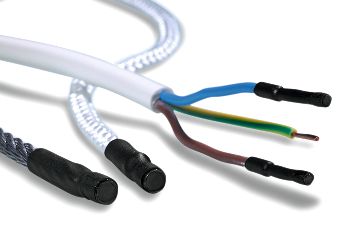
Heat-shrinkable end caps are specialised components used to seal the ends of cables, wires, or tubes. Made from heat-sensitive material, these caps shrink when exposed to heat, forming a tight, protective seal around the object they cover. Wire end caps are widely used in electrical, automotive, marine and industrial applications to prevent moisture ingress, protect against dust, chemicals, and corrosion, provide mechanical strain relief, and insulate live cable ends.
HellermannTyton offers heat shrink end caps for sealing and insulating cable ends in low-voltage applications. These plastic end caps are made from polyolefin and often come with a thermoplastic adhesive lining that melts during heat application, ensuring a watertight and secure seal. Many of our variants allow for printing on the surface, making the heat shrink tube end caps ideal for identification and labelling purposes.

The Helashrink 1600 plastic end cap series from HellermannTyton is engineered to provide reliable sealing and insulation for low-voltage cable applications. Their robust design and adhesive lining ensure a secure environmental seal, making them suitable for a wide range of cable types (including polymeric, paper-insulated, and lead-jacketed cables). Whether the cables are aluminium or steel-armoured, low voltage wire end caps and blind end caps deliver dependable insulation.
Our heat-shrinkable end caps are perfect for low voltage use because:
• Electrical insulation: Low voltage wiring end caps provide safe termination for cables up to 0.6/1 kV
• Moisture protection: Heat-shrinkable adhesive-lined end caps prevent corrosion and short circuits in damp environments
• Flexible compatibility: Our low voltage tubing and wiring end caps work with PVC, XLPE, PILC, rubber, and other common cable jackets
• Easy installation: Our cable end caps shrink quickly with heat, forming a secure and permanent seal
Low voltage wiring end caps are widely adopted across sectors such as energy, telecommunications, and transportation, where maintaining cable integrity is critical to operational safety and performance. They are also commonly used for sealing spare wires during cable storage, waterproofing cable terminations in outdoor systems, and protecting stub splices in automotive harnesses.

Pinched end caps are pieces of heat shrink tubing shrunk onto a filler to create an end cap. They are designed to seal and protect wire ends, such as stub splices. These wiring end caps in the PEC series are made from cross-linked polyolefin and feature a thermoplastic adhesive lining that ensures a secure, moisture-resistant seal.
HellermannTyton offers four models of pinched wire end caps, each with a 3:1 shrink ratio, allowing for a tight fit over a wide range of wire diameters. These heat shrink end caps are thin-walled, which helps reduce weight as well as installation time, while maintaining excellent mechanical and electrical properties.
Key benefits of our pinched wiring end caps:
• Operating temperature: –45 °C to +125 °C
• Minimum shrink temperature: +120 °C
• Adhesive softening point: +85 °C
• Dielectric strength: 15 kV/mm
• Flammability: Self-extinguishing within 30 seconds
• ROHS and ELV compliant

HellermannTyton’s end caps in the 1600 series stand out for their ability to be professionally printed with repetitive markings. The printing is offered as part of our service - combining robust insulation with clear, consistent identification. This feature is particularly valuable in industrial settings where traceability, safety, and compliance are critical. The outer surface of the heat-shrinkable end caps is optimised for thermal transfer printing, enabling clear, durable labelling that withstands exposure to chemical, abrasion, and temperature fluctuations. Monochrome logos, barcodes, QR codes, data matrix, and free text — including incrementation — can be printed on 1600-series heat-shrinkable end caps.
Use cases of printable end caps:
• Cable sealing during transport or storage: our plastic hose end caps prevent moisture ingress and mechanical damage, while allowing printed identification for inventory or maintenance tracking
• Insulation of live low-voltage cables: Electrical wire end caps are suitable for polymeric, paper-insulated, or lead-jacketed cables, including those with aluminium or steel armouring - printable surfaces help mark voltage ratings or circuit IDs directly on the cap
• Industrial environments: In sectors like energy, telecommunications, and transportation, end caps for tubing and wiring ensure cable integrity - printability guarantees clear, durable labelling for compliance and traceability
A heat-shrinkable end cap is an accessory made of polyolefin material that shrinks when heated, to protect and insulate the ends of cables, providing mechanical and electrical sealing thanks to its internal adhesive.
Shrinkable end caps are meant to protect, insulate and seal the ends of cables whereas blind flanges are used in piping systems to assemble, close or connect pipes.
A heat-shrinkable end cap ensures a hermetic seal against water and dust thanks to its hotmelt adhesive inner wall which melts and flows into all gaps and cavities when the outer wall shrinks under the effect of heat. Plus, heat shrink end caps of the 1600-series by HellermannTyton are UV and weather resistant.
HellermannTyton’s heat-shrinkable end caps are designed to cover cable diameters ranging from 1 mm to 80 mm, making them suitable for a wide variety of applications. They feature a shrink ratio of up to 3:1, ensuring a tight and secure fit.
To select the appropriate end cap for your application, consider the minimum and maximum diameters of the cable. Applying the 80/20 rule - where the cable diameter should ideally fall within 80% of the end cap’s shrink range - helps ensure optimal sealing performance. HellermannTyton offers a heat shrink calculator to help choose the right product.
The ideal heating tool to shrink down heat shrink end caps is the cordless hot air gun, gas powered CHG900.